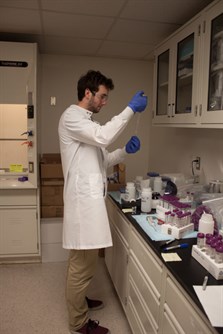
The United States has produced more than 70,000 metric tons of used nuclear fuel over the past 60 years from nuclear power generation. There is currently no available repository capable of containing this large amount of used nuclear fuel, which is expected to double within the next 30 years. The U.S. has also not implemented any reprocessing methods for this used nuclear fuel on a large-scale.
According to Andrew Wilcox, a student in the Center for Nuclear Security Science & Policy Initiatives (NSSPI), “Only about 4 percent of the uranium in nuclear fuel is used for power generation, meaning that about 96 percent of the original uranium is disposed with other nuclear waste, along with a portion of plutonium, which can also be recycled. In addition to this, isotopes of Am and Np are produced in this power generation and remain significantly radioactive for tens of thousands of years. However, it is known that the actinides–uranium, neptunium, plutonium and americium–can be reprocessed and burned up in a nuclear reactor as fuel or otherwise.”
Wilcox is working with his advisor Dr. Jonathan Burns, an associate research scientist at NSSPI, to explore a simple reprocessing technique called co-crystallization to separate these elements, which could be reused as fuel from the remaining used nuclear fuel. This co-crystallization technique could contribute significantly to reducing both the amount of waste currently stored, mostly at reactor sites, as well as waste that would be produced in the future.
Wilcox and Burns are studying the dissolution behavior of sodium bismuthate in a system that is comparable to the feed stream of a used nuclear fuel process. The development of a group separation of the recyclable actinides U, Pu, Np and Am could significantly simplify the closure of the nuclear fuel cycle, while reducing the amount of nuclear waste produced.
One major benefit to this group co-crystallization is that it sidesteps the difficult separation of Am3+ from Cm3+ and the trivalent lanthanides, which are present in used nuclear fuel, by oxidizing Am3+ to AmO22+. Prior to oxidation, this separation is challenging because these elements share the same chemical charge and have very similar size characteristics; however, upon oxidation, differences in chemical and physical properties are present to isolate the desired species and remove them from the system. Wilcox has been observing the various properties of sodium bismuthate that could be used in achieving this feat.
Wilcox graduated from the New Mexico Institute of Mining and Technology in 2016 with a Bachelor of Science in chemical engineering. He is looking forward to defending his master’s thesis on this research this month. His research is part of a larger effort to fully develop the co-crystallization reprocessing technique by Burns and his colleagues in the Chemical Separations Group at Oak Ridge National Laboratory and the Aqueous Separations & Radiochemistry Group at Idaho National Laboratory. The project is sponsored by the Fuel Cycle Research and Development program, Office of Nuclear Energy, U.S. Department of Energy and the Nuclear Energy University Program, Office of Nuclear Energy and the U.S. Department of Energy, under Award no. DE-NE0008653.
